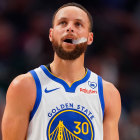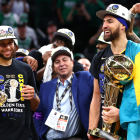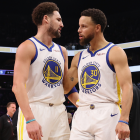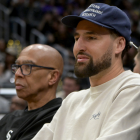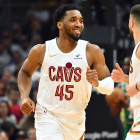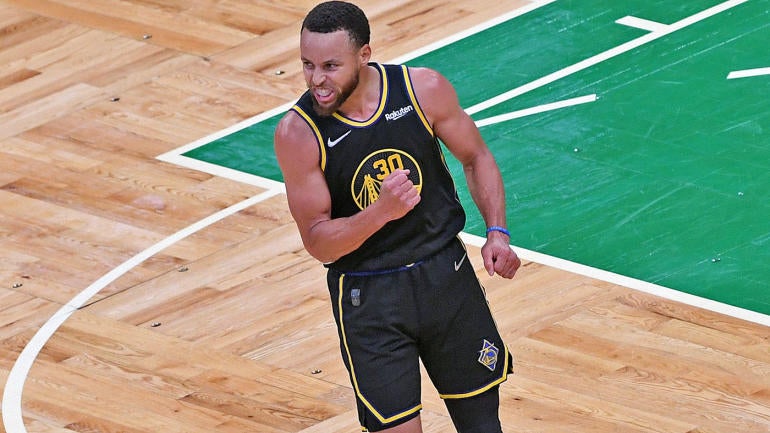
Take nothing away from Stephen Curry. Shooting 49 percent from 3 in the NBA Finals, on more than 12 attempts per game, is nuts. That said, the Celtics are kind of rolling out the red carpet for him to do this. Drop coverage against Curry is failure. Always has been. It invites the greatest shooter in NBA history to dribble into pull-up 3s against a retreating big man, with the only contest coming from the guard fighting over the top of the screen, who just isn't going to get there in time.
It's leading, relatively speaking, to a ton of comfortable, rhythmic 3-point shots for Curry, and he's taking full advantage. You would think Ime Udoka would adjust at some point, but so far the first-year Celtics coach has not blinked. The Celtics don't blitz, as most teams do vs. Curry. Only two teams, the Thunder and Jazz, blitzed less frequently than Boston in the regular season. They like to rely on their guards to fight over screens. They trust their bigs to switch, though they haven't done a ton of that with Curry either.
I wrote about this after Game 1, in which Curry stormed out of the gates with a Finals record six first-quarter 3-pointers because Boston's bigs were starting below the 3-point line on pick-and-roll, then retreating from there. As that game progressed, Boston brought its bigs above the 3-point line, just a few steps higher, and it was enough to slow Curry down for the rest of the game.
The goal is to split the difference: Show just high enough to discourage Curry's pull-up, but then quickly retreat to avoid letting him turn the corner past the slower big and get downhill. It's playing with fire, trying to position your big in a manner so perfect that you end up defending Curry as a shooter and a penetrator, and too many times Boston is getting burned by either starting a step low or beginning the drop a beat early. Look how much room Al Horford allows Curry coming off this ball screen.
Double P&R for Curry, Horford defending the second screener. He's above the 3PT line and dropping back and yeah. pic.twitter.com/RVQOR0a28o
— Steve Jones Jr. (@stevejones20) June 9, 2022
That's way too easy for the guy who made pull-up 3s the most dangerous shot in the game. In this series, the Warriors are scoring over 116.9 points per 100 possessions when Curry is on the court. That would've registered as the best rating in the league in the regular season, and it's nearly three points per 100 better than Golden State scored with Curry on the court during the regular season.
The Celtics are a world-class defense. This is the NBA Finals. This should be a significantly harder scoring environment for Curry than the regular season, but it's been the exact opposite. He's getting what -- for him -- are routine shots. Curry probably can't remember the last time he got this many looks off the dribble.
To that point, it must be emphasized that the Celtics are still contesting Curry pretty hard from behind. THe bigs are dropping, yes, but the "rear-view contests" have been aggressive. Curry has hit more than a few shots with a trailing defender hovering over, if not outright fouling, him.
Steve Kerr notoriously despises pick-and-roll basketball. He doesn't want to put the ball in the hands of one player as everyone else stands around waiting for secondary involvement or spot-up 3s. It's been the source of great frustration for many Warriors fans over the last five years because Curry is so deadly in pick-and-roll.
But in Kerr's defense, Curry doesn't normally see drop coverage. If he did, Kerr would be insane to not run pick-and-roll more often. He's doing it in this series to counter Boston's off-ball switching and ensure Curry gets his touches and shots without much else on Golden State's offensive menu. If Kerr is getting Curry the shots he wants by virtue of the defense, it begs the question: Why are the Celtics doing this?
Pretty simply, they don't want to compromise their coverage on everyone else by devoting two defenders to Curry, whom they don't believe can single-handedly beat them if limiting everyone else and staying out of extreme rotations. It's working, in a sense. Curry is averaging more than the next two highest-scoring Warriors -- Andrew Wiggins and Klay Thompson -- combined, and Draymond Green has, for the most part, been a complete non-factor offensively.
If the Celtics start blitzing Curry, that's when Green can get unlocked as a 4-on-3 playmaker, where he's made his offensive living the last half decade. It opens up Thompson for catch-and-shoot 3s, his forte, rather than having to create more off the dribble as Boston stays conventional in its Curry coverages.
The Celtics have only blitzed three times in this series. They tried it once out of desperation at the end of Game 4, and it played out accordingly with Green all alone going downhill to find Kevon Looney for a layup.
BOS started to put Smart on Curry more, but may have to go to it all game to slow him down in P/R. BOS tried putting 2 on ball late, didn't work. Also, think letting Draymond go 4 on 3 will get his confidence up, BOS needs to keep him down pic.twitter.com/hjBKGhcWiG
— David Jinks (@david_jinks13) June 11, 2022
If Green gets going as a playmaker, and suddenly Thompson is getting open 3-pointers on kick-outs as Boston's defense is forced to converge on the paint, that will open a whole new can of problems. Udoka has said he believes the Celtics would be up 3-1, at least, in this series had they just played sounder offense themselves, and he might be right. Curry's heroics notwithstanding, Golden State, for all its efficiency, is only scoring 105 points per game. Boston believes it should be able to beat that.
Still, it's hard to imagine Udoka letting Curry ignite again in Game 5 without at least trying something different, if only here and there. If he doesn't budge at all, and the Warriors go on to win this series behind an all-time Curry performance that was born of the most optimal of shooting circumstances, the first-year coach who has been nothing but praised throughout the second half of the season and through the postseason is going to have a lot to answer for.










